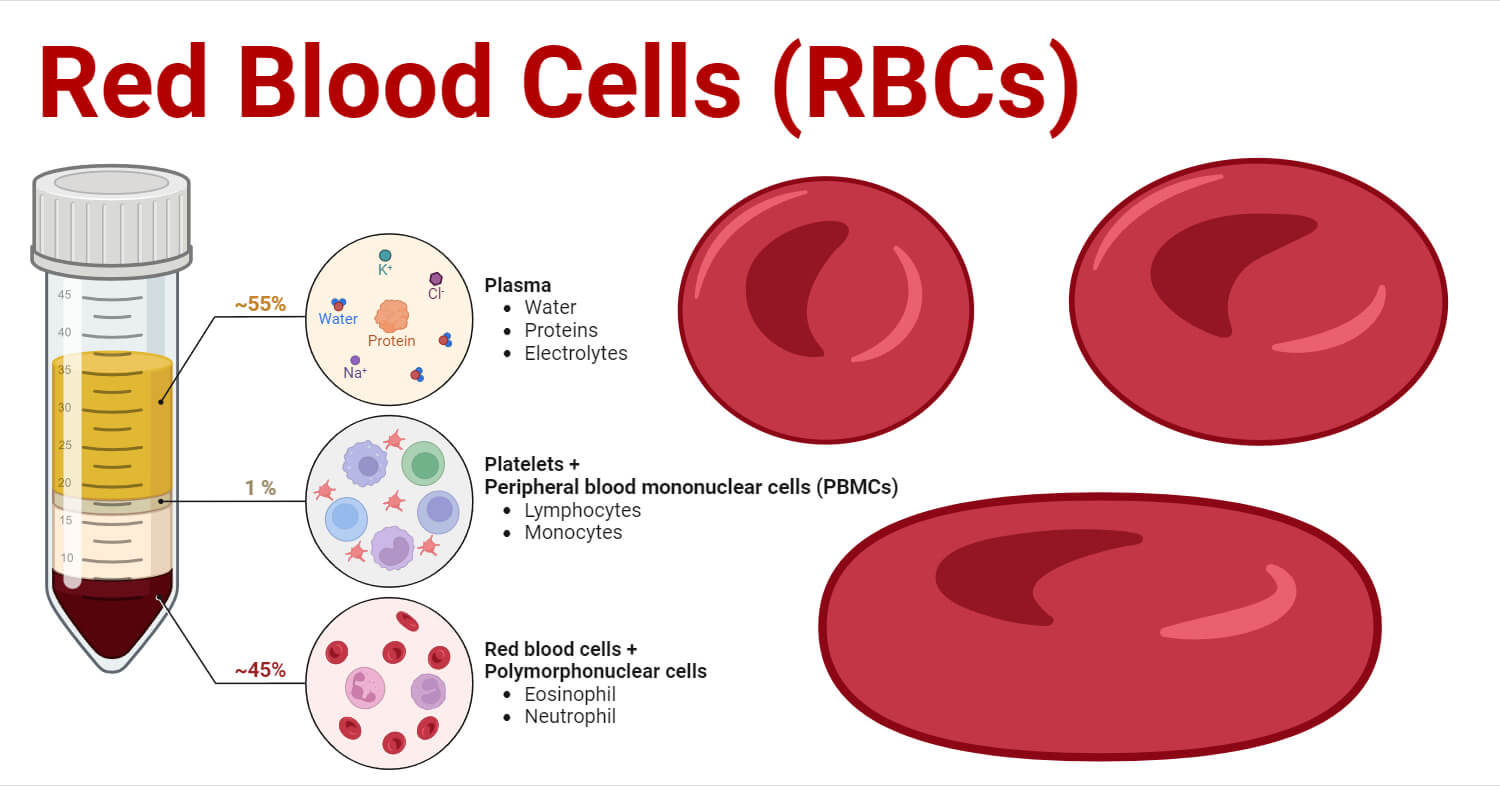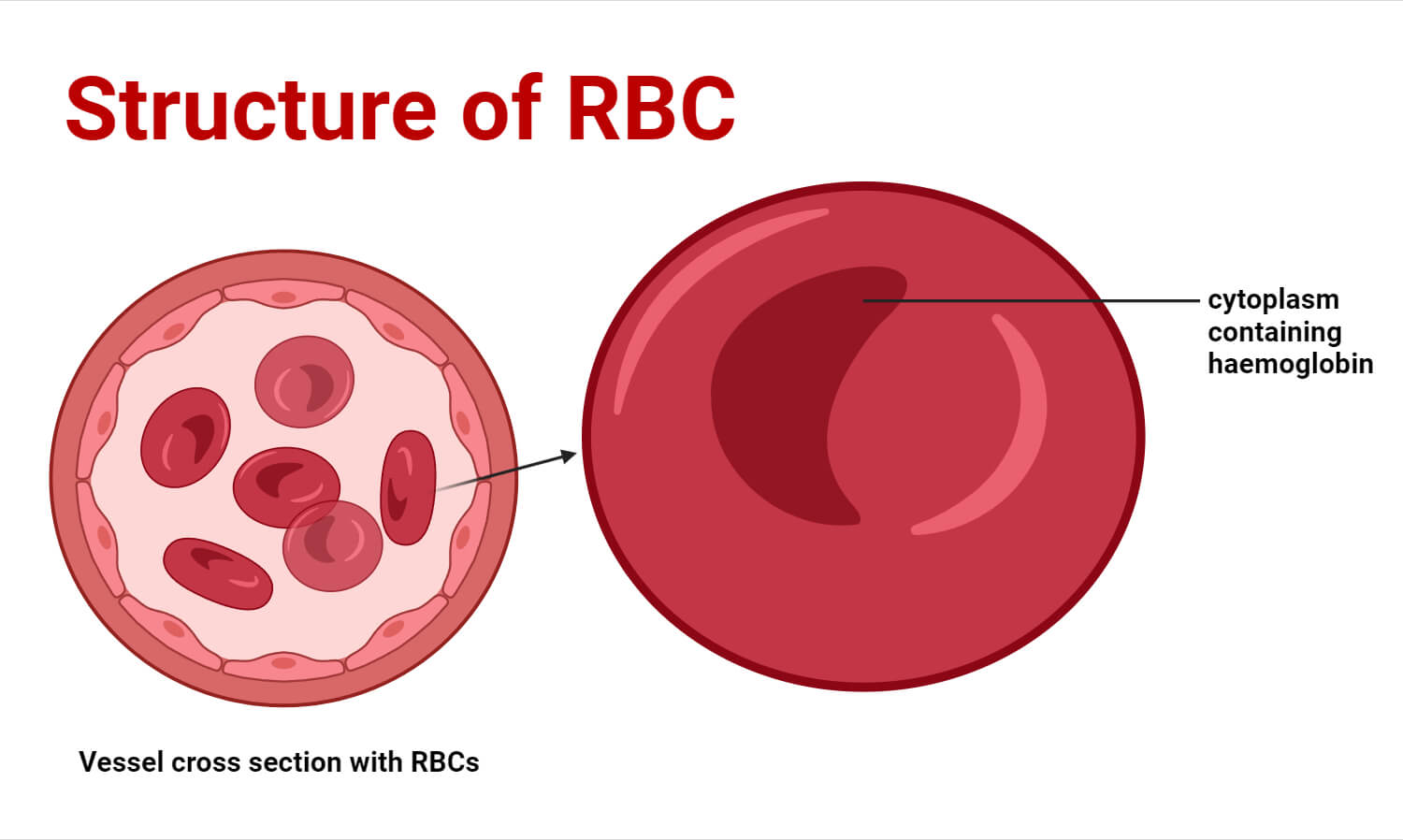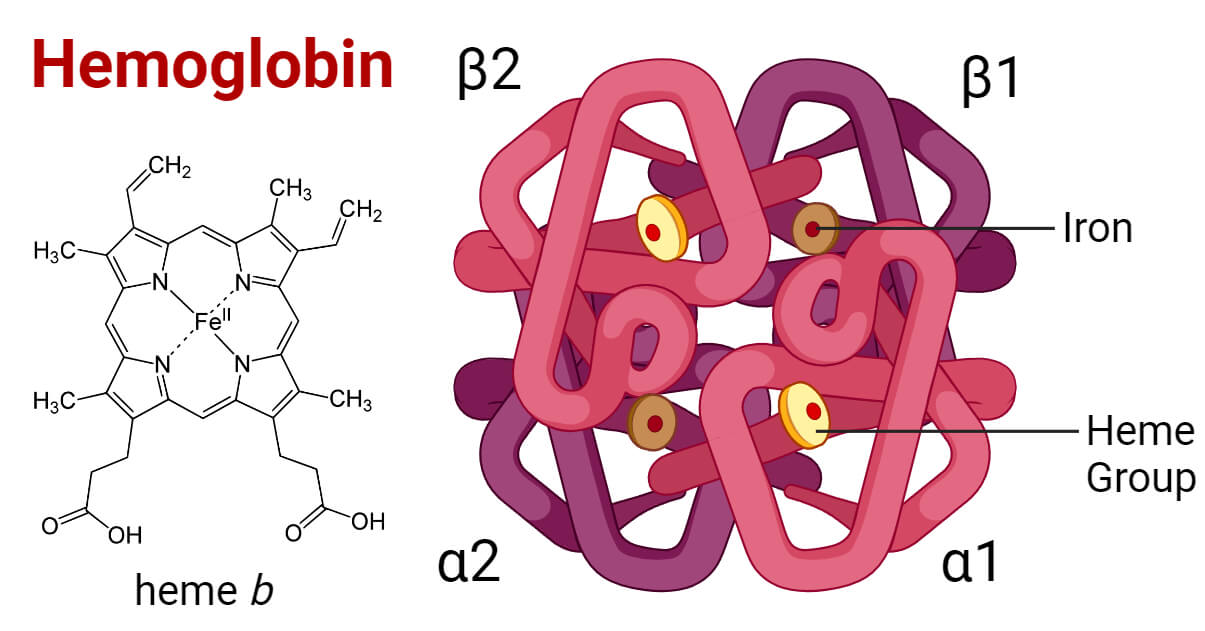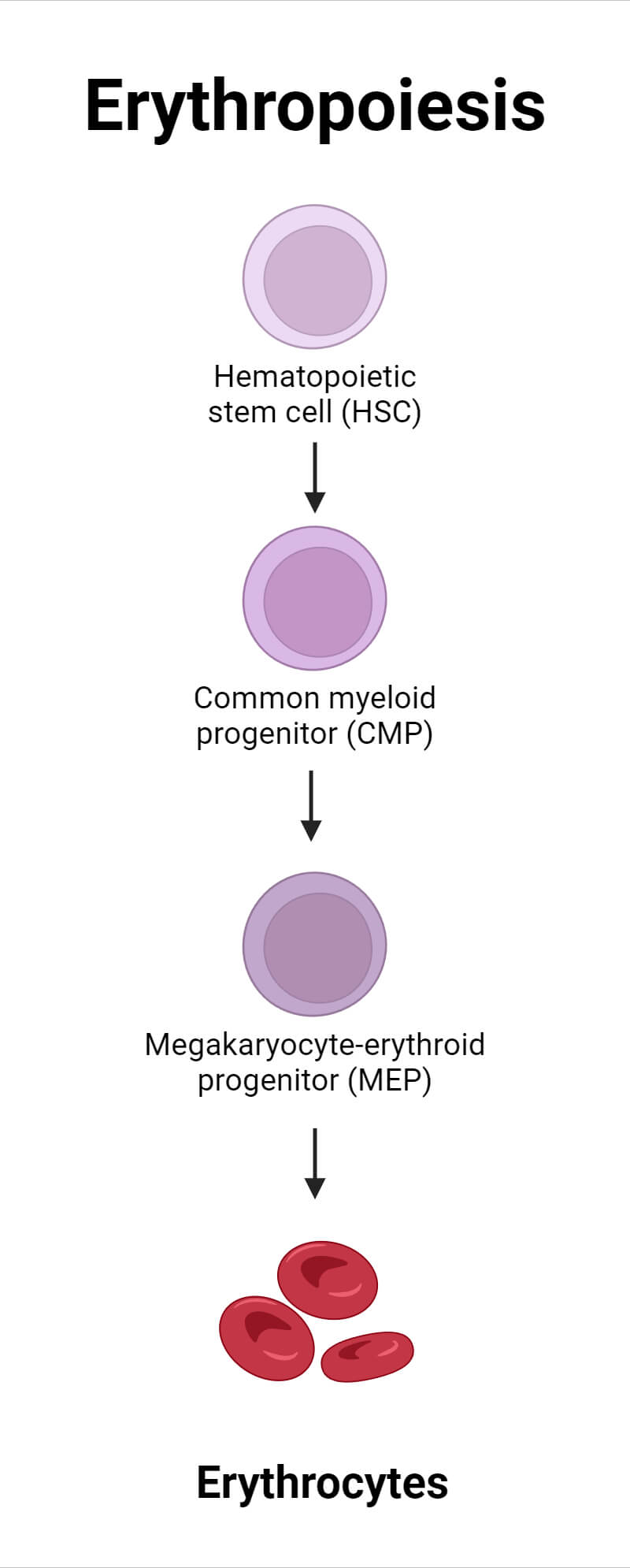Red blood cells or RBCs are also called erythrocytes. They serve as the functional components in blood which is responsible for the transportation of gases and nutrients across the entirety of the human body.

- They play a crucial role in oxygen transport as they contain hemoglobin.
- Hemoglobin is a protein that attach to oxygen and transports it from lungs to the body tissues.
- Normal erythrocyte concentrations in blood are around 3.9-5.5 million per microliter in women and 4.1-6 million per microliter in men.
- They appear red due to the presence of an iron-containing pigment called hemoglobin. Oxygen is absorbed by hemoglobin and supplied to various parts of the body.
- RBCs are formed in bone marrow located in the ends of long, flat, and irregular bones.
Interesting Science Videos
Structure of Red Blood Cells (RBCs)
- RBCs are unique in that they lack a nucleus and mitochondria, allowing them to contain more hemoglobin and perform their primary function efficiently.
- The red blood cells or erythrocytes are red-colored cells having a biconcave shape.
- They are flattened discs lacking nuclei and cytoplasmic organelles, containing the red protein hemoglobin for gas transport, primarily oxygen and some carbon dioxide.
- It measures 7.5 µm in diameter with 2.6 µm thick at the rim and 0.8 µm thick at the center.

The structure of RBCs can be described as follows:
- Biconcave shape: They are small, round and biconcave, which enables them to move through tiny blood vessels and reach the body’s tissue.
- Membrane: The cell membrane of an RBC is composed of proteins and lipids, providing structural integrity and malleability to the cell.
- Cytoskeleton: The cytoskeleton of an RBC is composed of proteins such as actin, spectrin, band 3, protein 4.1, ankyrin, which helps to maintain cellular structural integrity and flexibility.
- Hemoglobin: Each RBC contains approximately 270 hemoglobin molecules, which are responsible for oxygen transport.

Formation of hemoglobin
- Hemoglobin is a complex protein comprising of globin and iron containing haem, produced within developing erythrocytes in the red bone marrow.
- In mature erythrocytes, hemoglobin binds with oxygen to create oxyhemoglobin, imparting the characteristic red color to blood.
- Additionally, hemoglobin plays a crucial role in excretion. It help transport CO2 from body cells to the lungs.
- Each hemoglobin molecule contains four iron atoms, and each of these atoms can carry one molecule of oxygen.
- Consequently, a single hemoglobin molecule can transport up to four oxygen molecules.
Life cycle of Red Blood Cells (RBCs) (Erythropoiesis)
The lifespan of RBCs in circulation is approximately 120 days.
Erythrocytes originate in red bone marrow before entering the bloodstream and undergo multiple developmental stages.
Erythropoiesis is the process of RBC development from stem cells that takes around seven days.

The life cycle of erythrocytes comprises three phases:
- Production
- Maturation and
- Destruction
1. Production
- Erythropoiesis primarily occurs in the bone marrow. It begins with hematopoietic stem cells (HSCs), giving rise to multipotent progenitors, which then develop into erythroid-committed precursors and mature RBCs.
- Erythropoietin is the primary regulator of erythropoiesis, driving RBC precursor proliferation and differentiation and preventing erythroblast apoptosis.
2. Maturation
The maturation process involves several morphological changes to produce highly functional specialized cells. This process includes the expulsion of the nucleus and the loss of organelles, such as the smooth and rough endoplasmic reticulum, Golgi apparatus, and ribosomes, leading to the formation of mature biconcave RBCs.
3. Destruction
Mature RBCs have a lifespan of about 120 days. At the end of their lifespan, they are removed from circulation and destroyed, primarily by macrophages in the spleen and liver.
Functions of Red Blood Cells (RBCs)
- Respiratory gas transport: The primary role is transporting respiratory gases.
- Oxygen transport: Hemoglobin in RBCs combines with oxygen, forming oxyhemoglobin. Approximately 97% of oxygen transports as oxyhemoglobin.
- Carbon dioxide transport: Hemoglobin combines with carbon dioxide forming carboxyhemoglobin and approximately 30% of CO2 is transported. RBC contains carbonic anhydrase, crucial for converting water and carbon dioxide to bicarbonate, facilitating carbon dioxide transport (about 63% in this form).
- Buffering action: Hemoglobin serves is an effective buffer, regulating Hydrogen ion concentration and contributing to maintaining acid-base balance.
- Blood group determination: RBCs carry blood group antigens (A, B, and Rh factor). This aids in blood group determination and prevents reactions in incompatible blood transfusion.
Roles of Red Blood Cells (RBCs) in Immunity
RBCs play a crucial role in the immune response against pathogens. They are primarily known for their oxygen transport function. They contribute to the innate immune response and some of the ways RBCs work against pathogens are:
- Binding and scavenging: RBCs can bind and scavenge chemokines, nucleic acids, and pathogens in circulation, which helps in the clearance of these substances and reduces their potential harm to the host.
- Phagocytosis: RBCs can be susceptible to phagocytosis in certain phagocytosis settings, leading to innate immune activation. For example, when plasma CpG DNA levels increase beyond homeostatic norms, such as during sepsis or infection, TLR9-dependent binding to RBCs results in causing anemia and innate immune activation.
- Reactive oxygen species (ROS) production: In erythrocytes, hemoglobin and heme stimulate reactive oxygen species (ROS) to eliminate and destroy hemolytic pathogens.
- Immune recognition: Certain blood group antigens on red blood cells are present on molecules with receptors for specific microbes, resulting in hemolysis. This interaction can happen when hidden antigens become exposed, when microbial toxins change the characteristics of the antigens, or when microbes directly affect the formation of new red blood cells.
References
- Waugh A and Grant A (2018), Ross and Wilson Anatomy and Physiology in Health and Illness, 13th edition.
- Moras, M., Lefevre, S. D., & Ostuni, M. A. (2017). From erythroblasts to mature red blood cells: organelle clearance in mammals. Frontiers in Physiology, 8. https://doi.org/10.3389/fphys.2017.01076
- Moras M, Lefevre SD, Ostuni MA. From Erythroblasts to Mature Red Blood Cells: Organelle Clearance in Mammals. Front Physiol. 2017;8:1076. Published 2017 Dec 19. doi:10.3389/fphys.2017.01076
- Barbalato L, Pillarisetty LS. Histology, Red Blood Cell. [Updated 2022 Nov 14]. In: StatPearls [Internet]. Treasure Island (FL): StatPearls Publishing; 2024 Jan-. Available from: https://www.ncbi.nlm.nih.gov/books/NBK539702/
- https://www.nature.com/articles/s41577-021-00648-2.pdf
- News-Medical. (2022, April 22). The immunological functions of red blood cells. Retrieved from https://www.news-medical.net/health/The-Immunological-Function-of-Red-Blood-Cells.aspx
- Red blood cells may be immune sentinels. (2024, April 22). Retrieved from https://www.science.org/content/article/red-blood-cells-may-be-immune-sentinels
- https://conursing.uobaghdad.edu.iq/wp-content/uploads/sites/20/2019/10/The-Blood.pdf
- Themes, U. (2016, June 16). The blood. Retrieved from https://basicmedicalkey.com/the-blood/
- Moras, M., Lefevre, S. D., & Ostuni, M. A. (2017). From erythroblasts to mature red blood cells: organelle clearance in mammals. Frontiers in Physiology, 8. https://doi.org/10.3389/fphys.2017.01076
- Moras M, Lefevre SD, Ostuni MA. From Erythroblasts to Mature Red Blood Cells: Organelle Clearance in Mammals. Front Physiol. 2017;8:1076. Published 2017 Dec 19. doi:10.3389/fphys.2017.01076
- Jeffrey McCullough; RBCs as targets of infection. Hematology Am Soc Hematol Educ Program 2014; 2014 (1): 404–409. doi: https://doi.org/10.1182/asheducation-2014.1.404
- Anderson HL, Brodsky IE, Mangalmurti NS. The Evolving Erythrocyte: Red Blood Cells as Modulators of Innate Immunity. J Immunol. 2018;201(5):1343-1351. doi:10.4049/jimmunol.1800565
- Erythropoiesis – Process – Regulation – TeachMePhysiology. (2023, September 30). Retrieved from https://teachmephysiology.com/immune-system/haematology/erythropoiesis/
